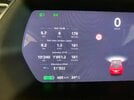I own a model Y standard range and a 2015 Nissan leaf. I ran an efficiency test between the two where I measured energy going in and how many miles I got out in city driving, where there's an 80% chance of stopping at a red light on every block. The temperature outside was about 80 degrees.
The results came out to be that the model Y clocked in at 512wh/mi and the leaf at 335wh/mi.
I haven't tried comparing highway efficiency yet, but I'm certain the model Y will beat my leaf on the highway. However, I'm really disappointed that my Tesla efficiency in the city is so much worse my leaf. Tesla has been touted as highly efficient, but no so in my case. I realize that the model y is a much heavier car but I didn't expect it to be this inefficient based on the the advertised city mileage.
Do you experience similar inefficiency driving in a busy city?
The results came out to be that the model Y clocked in at 512wh/mi and the leaf at 335wh/mi.
I haven't tried comparing highway efficiency yet, but I'm certain the model Y will beat my leaf on the highway. However, I'm really disappointed that my Tesla efficiency in the city is so much worse my leaf. Tesla has been touted as highly efficient, but no so in my case. I realize that the model y is a much heavier car but I didn't expect it to be this inefficient based on the the advertised city mileage.
Do you experience similar inefficiency driving in a busy city?




